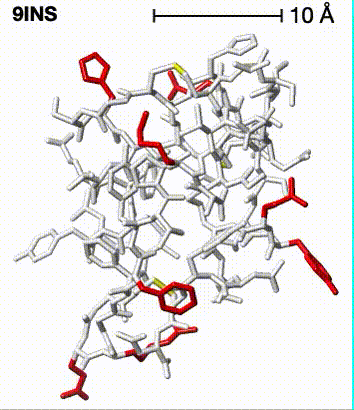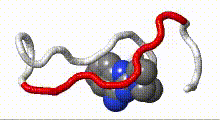Alternate locations
From Proteopedia
|
3 conformations of Arg201 in 7s99, with occupancy percentages. | |
Many PDB files have alternate locations (altlocs) for some atoms, marked with an altloc identifier, typically A and B. At sufficiently high resolution, two or more positions may be visible in the electron density map for certain atoms. If 2 alternate locations have approximately equal densities, each alternate location will be assigned an occupancy of 50%. Sometimes 3 or even more alternate locations may be distinguished (see examples below).
Contents |
Conformations
|
Two conformations in 9ins animated by FirstGlance in Jmol. Animation captured as a GIF.
|
Multiple alternate locations for atoms represent multiple conformations that the molecule can adopt. (The term conformations means differences due to rotations of covalent bonds, without removing or adding any covalent bonds. The term configurations means differences in covalent bonds.) As an example, the tiny protein insulin has 51 amino acids. In 9ins (resolution 1.7 Å), 8 sidechains have 2 alternate locations each (48 atoms, or 10% of its 484 atoms). It is important to realize that movements of these sidechains will mostly be independent of each other. Thus, there could be 28 or 256 conformations. In the PDB file, each sidechain location is marked A or B (%A or %B in Jmol language). When FirstGlance animates the alternate locations, for the sake of simplicity, it shows all the A locations together, and then all the B locations together. Note that this is greatly oversimplified, showing 2 conformations instead of 256. And since empirically-determined models are mostly static, while real molecules vibrate, even 256 conformations is an underestimate.
Prevalence of alternate locations
The Alternate Location Server of OCA by Jaime Prilusky lists all PDB entries with alternate locations, updated weekly. In May, 2023, 43% of PDB entries had one or more atoms with alternate locations, and this percentage was unchanged in August, 2025.
- 49.5% of X-ray crystallography entries have alternate locations in May, 2023 (50.4% in August, 2025).
- Through the year 2000, less than 20% of X-ray entries had alternate locations. Since 2010, about 60% of X-ray entries have alternate locations.
- 91.2% of those include alternate locations for alpha carbons or phosphorus atoms (backbone atom alternate locations; May 2023). Less than one third of entries had backbone atom alternate locations in X-ray entries deposited through the year 2000. That jumped to nearly 80% for entries deposited 2001-2010, and >95% in subsequently deposited entries.
- Only 9% of electron microscopy entries have alternate locations (May, 2023; 10% in August, 2025), but 94% of those that do include backbone atom alternate locations.
See also Alternate locations of backbones.
- Only 0.2% (23/13,905) of NMR entries have alternate locations, and 39% (9) of those include backbone atom alternate locations.
Visualizing alternate locations
|
Loop 174-199 in 4nvk has 4 conformations: 1 2 3 4. N->C Rainbow view of FirstGlance, colored by conformations. Animation of backbone alternate locations by FirstGlance version 4.3 released August, 2024. Animation captured as a GIF. |
FirstGlance in Jmol tells you how many atoms have alternate locations (when you are in more details mode), and the range of occupancies assigned to them. It tabulates summaries of alternate locations and occupancies, with links that highlight subgroups. It can animate alternate locations. Examples (from FirstGlance in Jmol):
The links below display the model in FirstGlance. Right click the link to open it in a new browser tab. Look in the Molecule Information Tab to click on Show More Details, then click on alternate locations.
- Glu3 in 3HYD. The atom with the largest distance between its alternate locations is the sidechain epsilon oxygen 1 (OE1), with 1.66 Å between alternate locations. Here are its ATOM records from the PDB file. The vertical bar points to the column with the altloc A and B designators. Each location is assigned 50% occupancy ("Occ" column).
| X Y Z Occ Temp ATOM 49 OE1AGLU A 3 9.326 0.609 10.555 0.50 4.93 ATOM 50 OE1BGLU A 3 8.211 1.826 10.769 0.50 8.58
- 9ins is insulin. Eight amino acid sidechains on the surface have two alternate rotamer locations each. Occupancies range from 40-60%.
- 1BSZ: Arg155 in chain A has 3 sidechain positions, each given an occupancy of 33%.
- 1ALX has one methanol in 5 alternate locations, each with 20% occupancy; another methanol in 4 alternate locations, each with 25% occupancy; as well as other moieties with 3, 2, and 1 locations/atom. Surprisingly, the two alternate locations of residue 11 in chain A are different amino acids: Tyr and Trp.
- 1izh is an unusual example. Its ligand is modeled in two completely different, overlapping orientations, indicated as alternate locations A and B.
Jmol vs. alternate locations
In the PDB file, atoms with multiple alternate locations are usually marked with AltLoc codes A, B, C, etc. In Jmol, these atoms can be selected with %A, %B, etc.
Jmol can also display multiple conformations with the commands "conformation 1", "conformation 2", etc. Jmol does this intelligently. Conformation 1 includes atoms with no AltLoc codes, atoms with only a single AltLoc code (thus only one location), and the first location for every atom with an alternate-location code that has multiple locations. This first location may or may not be coded A, since the codes can be arbitrary alphanumeric characters. Thus, Conformation 1 is often not simply the common atoms plus the %A atoms.
Similarly, Jmol defines Conformation 2 as atoms with no AltLoc codes, atoms with only a single AltLoc code (thus only one location), and the second location for every atom with an alternate-location code that has multiple locations. This second location may or may not be coded B.
Details of how FirstGlance defines conformations.
Models with the most alternate locations
The OCA Database and Browser highlights the structure with the most 'altlocs'. See Believe It or Not! within Proteopedia for that Protein Data Bank entry and other information mined by OCA.
PDB Format
The altloc identifier occupies the 17th column in ATOM/HETATM records: PDB format. See the example above.
CIF Format
The PDB to PDBx/mmCIF Data Item Correspondences shows that altloc information is in _atom_site.label_alt_id records in mmCIF files.
See Also
- Alternate locations of backbones summarizes the sizes of backbone pathway "forks" due to alternate locations, and lists some cases with important functional consequences.
- Atomic coordinate file
- Protein Data Bank
- Standard Residues
- Non-Standard Residues
- Hetero atoms
- Ligand
- Temperature value




